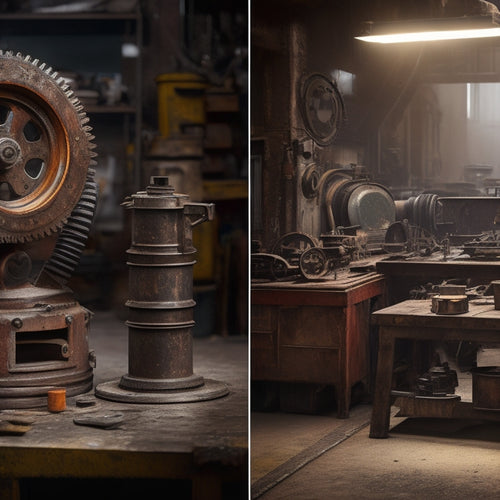
Optimizing Solar Panel Systems for Small Homes
Share
When optimizing a solar panel system for your small home, a thorough assessment of your roof's size, shape, and obstacles is vital in determining the ideal system configuration, panel selection, and energy output. You'll need to examine roof geometry, pitch, and orientation, as well as potential shading sources. Then, determine your energy requirements by evaluating your daily energy usage patterns and identifying areas of high consumption. By understanding your energy needs and roof constraints, you can configure your solar panel system to maximize energy harvest and optimize performance. There's more to explore, and a more detailed analysis will help you tap into your system's full potential.
Key Takeaways
• Assess roof size and shape to determine available space for optimal panel installation and energy production.
• Select suitable solar panels considering monocrystalline, polycrystalline, and thin-film options, weighing efficiency, cost, and performance.
• Calculate daily energy requirements by evaluating energy usage patterns, peak hours, and appliance consumption to determine required solar panel capacity.
• Ensure proper panel alignment, configuration, and inverter selection to maximize energy harvest and system performance, while minimizing energy losses.
• Optimize system performance by mitigating shading effects, adjusting panel angle, and considering climate and location-specific factors for ideal energy output.
Assessing Roof Size and Shape
When evaluating your roof's suitability for solar panels, measure its size and shape to determine the available space for panel installation.
You'll want to assess the roof geometry, taking into account the pitch, orientation, and obstacles that may affect panel placement. A south-facing roof with a pitch between 15° and 40° is ideal, but don't worry if your roof doesn't meet these conditions – solar panels can still be installed on roofs with different orientations.
Identify roof obstacles such as skylights, vents, and chimneys that may block sunlight or hinder panel installation. You'll need to work around these obstacles to guarantee proper panel placement.
Consider the available space on your roof and calculate the maximum number of panels that can be installed. A thorough assessment of your roof's size and shape will help you determine the ideal solar panel system for your home.
Choosing the Right Panel Type
As you explore the world of solar panels, you'll encounter various types, each with its strengths and weaknesses.
You'll need to decide between monocrystalline and polycrystalline silicon panels, which differ in their crystal structure and efficiency.
Thin-film photovoltaics, another option, use a different technology altogether, offering a unique set of benefits and drawbacks.
Monocrystalline Vs Polycrystalline
You're likely wondering which type of solar panel to choose for your installation, and the decision largely hinges on the choice between monocrystalline and polycrystalline panels.
Both options have their advantages and disadvantages, which you should consider carefully.
Monocrystalline panels are made from a single crystal of silicon, resulting in higher cell efficiency (15-20%) and a sleeker appearance.
However, they're more expensive due to the complex manufacturing process, which increases their material cost. This higher efficiency comes at a price, making them less suitable for small homes with limited budgets.
Polycrystalline panels, on the other hand, are made from multiple silicon crystals, resulting in lower cell efficiency (12-15%) and a more rugged appearance.
Although they're less efficient, they're also less expensive to produce, making them a more affordable option.
When deciding between monocrystalline and polycrystalline panels, consider your budget and energy requirements.
If you prioritize high efficiency and aesthetics, monocrystalline might be the better choice.
However, if you're on a tighter budget, polycrystalline panels can still provide reliable energy at a lower cost.
Thin-Film Photovoltaics
Thin-film photovoltaics emerge as a third option, offering a unique set of characteristics that diverge from traditional monocrystalline and polycrystalline panels.
They are made by depositing a thin layer of photovoltaic material onto a substrate, resulting in a more flexible and lightweight design. This manufacturing process allows for greater cost-effectiveness, making thin-film photovoltaics an attractive option for small homes.
Recent manufacturing advancements have improved the efficiency of thin-film photovoltaics, bridging the gap with traditional panel types.
While their efficiency may still lag behind monocrystalline and polycrystalline panels, thin-film photovoltaics offer a significant advantage in respect to cost. You can expect to pay around 20-30% less for thin-film photovoltaics compared to traditional panels.
Additionally, thin-film photovoltaics tend to perform better in low-light conditions, making them a suitable choice for homes with partial shading or in regions with limited sunlight.
When weighing your options, consider the trade-off between efficiency and cost-effectiveness, and determine whether thin-film photovoltaics are the right fit for your small home.
Determining Energy Requirements
As you determine your energy requirements, you'll need to examine your energy usage patterns to identify areas of high consumption.
Evaluating your daily energy demands helps you pinpoint the times of day when your energy needs are highest.
Energy Usage Patterns
To determine the required solar panel capacity, analyzing your daily energy usage patterns is vital, identifying the peak hours of consumption and the overall daily energy requirements. You need to understand how and when you use energy in your home.
For instance, do you consume more energy in the morning when you're getting ready for work or school, or in the evening when you're cooking dinner?
Knowing these patterns will help you size your solar panel system accurately.
One effective way to analyze your energy usage is by using energy monitoring systems.
These systems track your energy consumption in real-time, providing you with detailed insights into your energy usage patterns.
You can identify the time of use rates, which are the specific periods when you consume the most energy.
This information is essential in determining the required solar panel capacity to meet your energy demands.
Assessing Daily Demands
You'll need to calculate your total daily energy requirements in watt-hours (Wh) by identifying the appliances and devices that consume the most energy in your home.
This involves tracking your morning usage patterns, including the energy required to power lights, refrigerators, and coffee makers. Additionally, consider your evening energy habits, such as watching TV or using computers.
Make a list of all the devices and appliances you use daily, along with their respective power ratings in watts (W). Multiply the power rating of each device by the number of hours you use it per day to get the total daily energy consumption in Wh.
For example, if you use a 10W LED light bulb for 8 hours, the daily energy consumption would be 10W x 8h = 80Wh.
Calculate the total daily energy requirements by adding up the energy consumption of all devices and appliances. This will give you a clear understanding of your daily energy needs, enabling you to determine the required capacity of your solar panel system.
Selecting the Ideal Inverter
When selecting an inverter, consider the type of solar panel system you have, as it will dictate the inverter's required voltage, current, and power ratings.
You want an inverter that can handle your system's maximum power output, guaranteeing efficient energy conversion.
Look for high inverter efficiency, typically above 95%, to minimize energy losses.
Power quality is also vital, as a high-quality inverter will provide a stable and clean AC output.
Additionally, consider inverter reliability, as a reliable inverter will reduce downtime and maintenance costs.
System monitoring capabilities are also essential, allowing you to track performance and identify potential issues.
In addition, consider the inverter's noise level, as a quieter inverter can be beneficial for residential installations.
Lastly, evaluate the inverter's cooling system, as a well-designed cooling system can maximize performance and extend the inverter's lifespan.
Configuring Panel Orientation and Tilt
Configure your solar panels at a precise orientation and tilt to maximize energy harvest, as even slight misalignments can substantially reduce overall system performance.
When determining the ideal orientation, consider the Panel Azimuth, which is the compass direction your panels face. For peak energy production, panels should face within 20 degrees of true south in the northern hemisphere. In the southern hemisphere, panels should face within 20 degrees of true north.
To calculate the ideal tilt, you'll need to perform Tilt Calculations. The general rule of thumb is to tilt your panels at an angle equal to your latitude minus 15 degrees. However, this may vary depending on your location and climate.
In regions with heavy snowfall, a steeper tilt may be necessary to facilitate snow slides off the panels. Conversely, in regions with high temperatures, a shallower tilt may be preferred to reduce heat gain.
Considering Shading and Obstructions
Optimizing your solar panel system requires careful consideration of shading and obstructions, as even partial shading can substantially reduce energy output.
As you assess your property, identify potential shading sources, such as tree canopies, neighboring buildings, and other structures.
Building proximity can also impact your solar panel system's performance, especially if nearby structures cast long shadows during peak sun hours.
To mitigate shading effects, consider pruning tree branches or relocating panels to minimize obstruction.
If possible, install panels on a roof section with minimal shading or on a ground-mounted system in an open area.
Conduct a thorough site assessment to identify potential shading patterns throughout the day and year.
This will help you optimize panel placement and maximize energy production.
Sizing the Battery Backup System
Determine the size of your battery backup system by calculating your daily energy requirements, taking into account your critical load's power consumption and the number of days you want the system to operate during an outage. This calculation will give you the total watt-hours (Wh) required.
To guarantee your battery backup system meets your needs, consider the following factors:
| Factor | Description |
|---|---|
| Depth of discharge (DOD) | The percentage of the battery capacity you're comfortable using, e.g., 50% for a 200Ah battery means using 100Ah |
| Cycle life rating | The number of charge/discharge cycles a battery can handle before capacity degrades, e.g., 3000 cycles |
| Battery type and chemistry | Different chemistries, like lead-acid or lithium-ion, have varying characteristics affecting system design |
Ensuring Electrical Code Compliance
You must verify that your solar panel system complies with local electrical codes and regulations to guarantee a safe and reliable installation.
Failure to do so can result in code violations, leading to costly rework, fines, or even system shutdown.
It's vital to familiarize yourself with the National Electric Code (NEC) and local amendments, as well as any additional requirements from your utility company.
As you design and install your solar panel system, make certain that all components, including the panels, inverters, and electrical connections, meet the necessary standards.
Pay attention to details such as wire sizing, grounding, and overcurrent protection.
It's also essential to involve your local inspector early in the process to avoid potential issues down the line.
Their involvement can help identify and address any potential code violations before they become major problems.
Frequently Asked Questions
How Often Should I Clean My Solar Panels for Optimal Performance?
Did you know that a 1% decrease in solar panel efficiency can result in a 1% loss in revenue? You should clean your solar panels every 6-12 months to prevent dust accumulation, ensuring peak performance through regular panel maintenance.
Can I Install Solar Panels on a Metal or Asphalt Roof?
You can install solar panels on a metal or asphalt roof, but consider the roof material's compatibility with panel attachment methods, such as clamps or adhesive, to guarantee a secure and watertight installation.
Are Solar Panels Resistant to Extreme Weather Conditions Like Hail?
"You'll be relieved to know that solar panels are rigorously tested for weather durability, withstanding fierce forces like hailstorms, ensuring storm resilience and maintaining their efficiency despite extreme weather conditions."
Can I Add More Panels to My System in the Future if Needed?
You can easily upgrade your system in the future by adding more panels, thanks to the inherent future scalability of modern solar panel systems, making it easy to adapt to your growing energy needs.
Do Solar Panels Generate Electricity During a Power Outage?
During a power outage, you won't generate electricity with solar panels alone, as they're designed to sync with the grid. However, with a backup power system, you can achieve grid independence and maintain electricity supply during outages.
Related Posts
-

Why Higher Upfront Costs Are Worth It
You pay a premium for high-quality, energy-efficient products, but they're worth it. With durability testing ensuring...
-

Step-by-Step Guide to Converting Your Vehicle to EV
You'll begin by evaluating your vehicle's conversion potential, analyzing its weight, aerodynamics, and powertrain co...
-

Why Invest in Residential Solar Panel Systems?
By investing in a residential solar panel system, you'll harness renewable energy, reducing your carbon footprint and...


